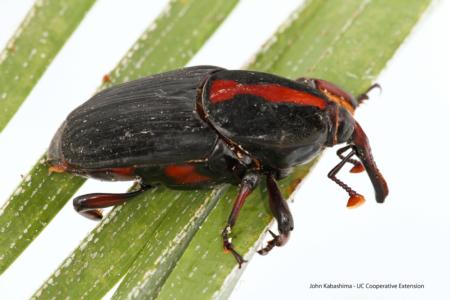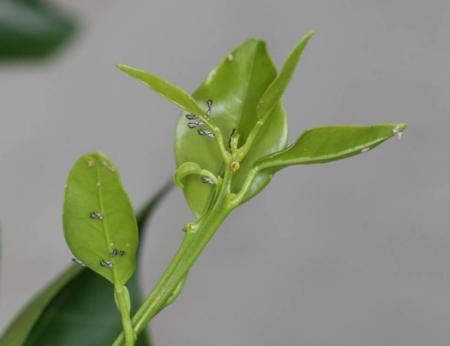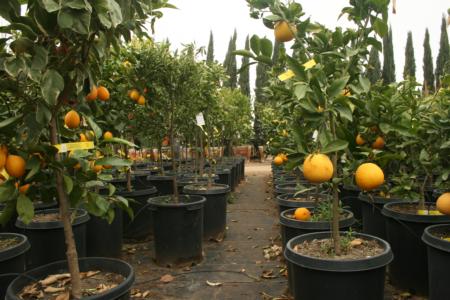Spring 2013
CAMPUS RESEARCH UPDATE: The red palm weevil invasion in Laguna Beach -by Mark S. Hoddle
In September 2008, inspection of a dead Canary Islands palm in Laguna Beach, Orange County, California, revealed the presence of a large weevil that was identified by USDA taxonomists as the red palm weevil (RPW), Rhynchophorus ferrugineus, a destructive pest of coconuts native to southern Asia. This insect has been classified by the Food and Agriculture Organization as the world’s most destructive palm pest — it has caused immense devastation to Canary Islands palms around the Mediterranean and to date palms in the Middle East and northern Africa. RPW has been moved internationally by the trade in live palm trees used for landscaping. In Egypt, it has been estimated that more than one million date palms have been killed by this pest.
Coloration in Rhynchophorus ferrugineus is extremely variable and has historically led to the erroneous classification of color-defined polymorphs (variants) as distinct species. The color morph for this global invader is orange with red spots, and the closest population of this color morph to the United States is in the Caribbean on the islands of Aruba and Curacao (it was introduced via live palm imports from Egypt for landscaping around hotels). Consequently, the first incursion into North America was expected to be Florida. The first detection of RPW in Laguna Beach in California was surprising, not only because of the location but also because it was a different color morph. This color morph, black with a red stripe (fig. 1), was previously known as R. vulneratus, and was synonomized with R. ferrugineus by Canadian researchers in 2004.

Fig. 1. Red palm weevil found in Laguna Beach, California. Photo courtesy of J. Kabashima, UC Cooperative Extension, Orange County.
DNA work at UC Riverside has revealed that these two weevils are indeed separate species. R. vulneratus was found in Laguna and it likely originated from Indonesia, possibly from the island of Bali. The mode of introduction of this weevil into Laguna Beach is undetermined. Palm imports into the United States have been banned to prevent the accidental introduction of RPW. One introduction hypothesis is that R. vulneratus was introduced for food: the larvae in parts of southeast Asia are considered a delicacy (http://cisr.ucr.edu/blog/invasive-species/entomophagy-collecting-and-eating-red-palm-weevil-larvae-from-nipa-palms-in-sumatra-indonesia/). Pheromone traps have failed to detect adult weevils for more than one year now and it is possible that focused pesticide applications to infested palms may have eliminated incipient populations in Laguna Beach.
More information can be found at http://cisr.ucr.edu/red_palm_weevil.html and on the associated blog: http://cisr.ucr.edu/blog/. Also, Jim Bethke published an article on palm weevils in his regional report for the UCNFA News fall 2011 edition, available at http://ucanr.edu/sites/UCNFAnews/newsletters/Download_UCNFA_News_as_PDF40180.pdf.
Mark S. Hoddle is Cooperative Extension Specialist, Department of Entomology, UC Riverside.
CAMPUS RESEARCH UPDATE: Managing Asian Citrus Psyllid Infestations in Nurseries -by Matt Daugherty
The Asian citrus psyllid (Diaphorina citri, fig. 1) has emerged as a major threat to California citrus, in large part due to its role as a vector of Huanglongbing disease. To ensure that nursery stock is not contributing to spread of the vector and disease (fig. 2), rules are in place that limit the movement and mandate treatment with insecticides of all psyllid host plants at nurseries. Nonetheless, well over 200 D. citri infestations have occurred at Southern California retail nurseries and garden centers, which has led to plants being put on hold or destroyed. Ongoing research by UC Riverside and Cooperative Extension personnel is investigating factors that undermine control of D. citri in nurseries. Prior studies have shown that systemic insecticide is maintained at effective concentrations for three months or more. Yet, preliminary results suggest that nursery stock commonly remains onsite for well over three months post treatment — more than a year in some cases. Future efforts will concentrate on working with nurseries to develop best management practices that encourage, among other things, the timely turnover of nursery stock.

Fig. 1. Asian citrus psyllid adults feeding on young citrus flush. Photo by Michael Rogers, University of Florida.

Fig. 2. Citrus and related plants in the family Rutaceae may host psyllids and Huanglongbing. Photo by Adam Zeilinger, UC Riverside.
Resources
Byrne FJ, Morse JG, and Bethke J. 2011. Optimization of imidacloprid application rates for the management of ACP on containerized citrus. Citrograph January/February Issue 2011, pp. 45-47.
Grafton-Cardwell EE, Godfrey KE, Rogers ME, Childers CC, and Stansly PA. 2006. Asian Citrus Psyllid. Oakland: Univ.Calif. Agric. Nat. Res. Publ. 8205. http://www.anrcatalog.ucdavis.edu/pdf/8205.pdf.
Matt Daugherty is an Assistant Extension Specialist, Department of Entomology, UC Riverside












